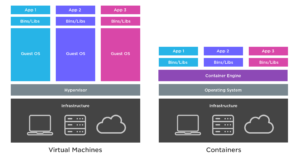Delivering Business Value With Containerization Technology

As the intense pressure in IT amplifies to move fast and deploy software efficiently, containerization has become a major trend to allow development teams to operate at an unprecedented scale.
With faster business cycles and higher customer expectations, containers are a common solution for DevOps teams by providing them with the flexibility, efficiency, feedback loops, and speed needed for more agile workflows.
What are containers?
Containers are virtual runtime environments that encapsulate an application’s code along with its files, dependencies, and libraries. With containerization technology, the application platform and its configuration files are bundled into a single package. Unlike virtual machines (VMs) where the hardware is virtualized to run multiple OS instances, containers implement a lightweight form of virtualization that shares a single operating system with the host computer.
Containers vs VMs
While there are still reasons to use VMs, containerization technology provides a level of flexibility in performance, scalability, and portability. For example, rather than having to set up and maintain a separate infrastructure for development, testing and production, the same base container configuration can be used to run all of these environments—supporting Agile and DevOps efforts to accelerate development, test, and production cycles. As the application runs, a DevOps team can quickly identify and monitor bugs.

Both containers and virtual machines (VMs) are software technologies that create self-contained virtual packages. Beyond that commonality, they differ in their operations, characteristics and use cases.
How Containerization Technology Delivers Business Value
From productivity to agility, the key advantages of containers include:
Containers unify development and production. You’ve likely encountered a scenario where features run fine on your development machine, but an error occurs once they get to production. That’s almost certainly because each environment was running a different machine. Containers eliminate this problem as you use the same container for both production and development environments, resulting in fewer bugs and fewer resources spent.
Containers enhance security. With containers, it’s easier to scan the entire application, its dependencies, and the entire abstracted OS. Updates and security patching are frequent, making it easier to change the environment as a part of an application update. Containers also eliminate the problem of failure due to compatibility issues between the app and patches.
Containers provide quick and easy deployment and scaling. With containers, there’s no more manually spinning up servers and VMs for every application. Container orchestration tools like Kubernetes ensure that containers are automatically deployed to available nodes, reducing the cost of administration and time to market.
Note that while microservices offer advantages, they can be challenging to deploy and monitor. Spreading functionality among smaller services means more integration points and more potential failure points—making monitoring essential for quick incident detection, response, and management. Kubernetes can be useful in such scenarios because it provides standardized monitoring points across deployments via functionality like DaemonSets, Metrics Server, and Prometheus.
Containers offer cost-effective operations. Containers provide easy mechanisms for adding and updating features in applications. Because they’re discrete, patches and feature upgrades are quicker. By using containers, companies can quickly test new features and upgrades on a small subset of customers before a full rollout. This allows for the prevention of costly implementation of individual elements that customers may not want.
How Containerization Technology Drives Digital Transformation
Digital transformation is when organizations integrate digital technology into every facet of their business resulting in fundamental changes in how they operate and how they deliver value to customers. It is becoming increasingly important for companies to embrace this change to remain competitive and relevant.
The benefits of containers can help enterprises enable and even drive digital transformation—rapidly and cost-effectively. But how?
First, companies can containerize their existing applications by defining them as configuration files rather than manual build steps. Container orchestration mechanisms like Kubernetes or Docker Swarm create containers directly from configuration files. Since configuration files can be part of your codebase and test/build processes, they work with automation in your continuous integration/continuous delivery (CI/CD) pipeline, which makes deployment and management easier. Compare that to the manual processes where DevOps engineers are bound to perform tasks such as build, testing, and deployment. Current operations won’t be interrupted, and personnel are freed up to spend more time on other projects.
Furthermore, new applications can be developed and deployed as containerized services and microservices. This enables rapid development that accelerates the digital transformation process.
Monitoring Containers Is Important
The arrival of Docker and the linking of service mesh technology to Kubernetes have contributed significantly to containerization technology growth. Containers are easy to manage and maintain which allows DevOps teams to operate in a continuous delivery model quickly. However, like integrating Kubernetes in CI/CD pipelines, without proper monitoring and incident response and management, they can cause unexpected problems.
Without monitoring, the DevOps team won’t be aware of issues that can result in site failure. For businesses of enormous scale, this can lead to a loss of millions of dollars. Luckily, however, when using containers you have plenty of opportunities to monitor each level of the CI/CD pipeline. Anything can happen at any of the CI/CD stages, whether build, test, or deployment. If you have an accurate monitoring system integrated with automatic incident response, it identifies issues proactively to avoid system failure.
But, what’s the use of all the monitoring data if you can’t act on it? That’s where incident response and management come into the picture. The integration of monitoring tools with incident response strategies helps you automate alerting and manual remediation or escalation tasks, which saves precious time in the case of global outages.
Incidents can block the deployment of updated containers. For continuous and efficient delivery of your application, your DevOps team must address incidents promptly. With the help of an adaptive incident management platform such as xMatters, it is possible to have timely and accurate alerts in the case of any form of incident. These accurate alerts help the DevOps team to decide if they want to apply a quick fix or revert to the previous version before impacting the valuable customer experience.
A best practice for SRE or DevOps teams is to avoid manual and repetitive work. In other words, if a disaster happens, your monitoring platform must give you relevant insights regarding the state of the container, where precisely the issue occurred, which build caused the failure and the next steps required.
Now, imagine having to complete such steps manually first, then having to make a Jira ticket and assign it to your developer. Wouldn’t it be more efficient if instead your monitoring platform would first identify any problems in the container’s delivery cycle, and its integration with Jira would then help you produce a ticket with valuable insights? The information passed on would help the development team mitigate the bug faster. This can be the case with the integration of xMatters to automate the process.
As an added benefit, xMatters also supports direct integration with the tools your teams live in, such as Slack, Jira, New Relic, and more. The automated workflows stemming from those direct integration are the key feature.
Next Steps
Containerization adoption is growing rapidly for organizations that wish to foster and accelerate digital transformation. However, as applications become more virtualized and fragmented, keeping track of performance issues can become a complex exercise.
To avoid such roadblocks, you’ll need a proper monitoring and incident prevention strategy that ensures incidents are dealt with right away without causing global operational outages or disruptions to the employee or customer experience.
This doesn’t have to be complicated to achieve. With xMatters, incident prevention can be easily attained due to its automated approach to incident response and container orchestration management. It gets even easier if you take advantage of xMatters’ GKE integration.
To find out how xMatters ensures greater uptime for your container strategy, sign up for a new xMatters account and start your free trial today.
